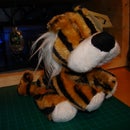Introduction: Refurbished Skateboard= Trick Style Balance Board! + VIDEO!
Intro,
Let's just start things off by saying that these are not my original ideas. Credits go to Sam Noyoun for his instructable on a carpet surfin' balance board.
https://www.instructables.com/id/EDD7R6KO9NEZ7BDXU9/
I am healing from injuries now and it is spring time so I am looking for a fun way to pass the time. Sam's project jumped out at me as something that I could both have fun using, and making.
This is a different style of balance board, directed more for tricks and extreme riding.
It is a video instructable. Although, I will ad some photo-free steps with dimensions.
Lastly, if I end up getting hatter comments becuase somebody has already made a balance board, then you clearly are not viewing this correctly...
MATERIALS NEEDED!
skateboard deck
1 by 3 inch wood blocks
drill
belt sander
drill bit and wood screws
Construction glue
soap
sandpaper
jigsaw, skill saw, table saw....saws
Foam weather strip
ABS of PVC pipe, anything hard, with a diameter of at least 3 3/4inches
Step 1: Video Instructable! Slackers Unite!
yay!
Step 2: First Step! Cleaning and Prepping!
I have a few skate decks lying around, two are old school, two are too expensive to destroy, so i went for the board out back, the one my friends and I use to jump of the deck in the summer.
It was "hella" dirty, water damaged, and covered in snow.
First I ran it under a warm bath to melt any snow/ice and remove large debris.
Secondly, I took a coarse brush and removed the finer dirt.
I then used a combination of bleach, industrial de-greaser, floor stripper, and plain hand soap -_- to remove any guck.
IT IS IMPORTANT TO WEAR HAND AND EYE PROTECTION WHILE USING HARSH CHEMICALS, don't take my video as an example. Please don't model after my stupidity.
Lastly, Once dried, I using a combination of sandpapers, a belt sander and a detail sander, to make a nice, smooth, clean surface to work with.
Now the board is prepped for assembly.
Step 3: Building Stuff!
Because we want to have fun, and not severely injure ourselves, we make stoppers on either side of the board, so we don't go flying of in the event of an over balance, shall I say...
I used pine board left over from a homemade t.v. stand, anything works.As long as it can be secured tightly to the board.
I cut two blocks about 1 inch wide by 3 inches long.
I then applied polyurethane glue to both the board and the stopper.
Next, drill some pilot holes, because pine is stupid, and it splits. Then insert some screws that wll go all the way through. If you are cool, like me....or just plain Canadian, you will use Robinson screws, because they are the utmost best screws on earth!
I put four screws on each stopper, so the block would conform to the decks concave.
Now you won't fall....
I've used my x-ray in past instructables. Just remember, if you don't make stoppers, your arm could end up like this, and oh boy, you don't want that! This is my left humerus about 2 months ago.
Step 4: What to Do With Those Spikes...
Now that you have stoppers, you have some crazy spikes coming out from the blocks. These are called screws. Now we don't want to ruin mom and dad's nice hardwood floors do we?
Take a dremel, if you don't have one, try and borrow one...they are amazing
You want a cut-off whell. I used a 1/26th thickness because the disc wears out after about 4 cuts...
Just put on some eye protection and start cutting off the sticky outy screws by placing the spinning disc firmly on the side of the screw. Don't use too much force, or the disc will shatter.
Now that you don't have spikes....you have some crazy mess on the stoppers, this is called BURNT WOOD AND METAL DUST! WOOO!
we can take care of this in the next step...
Step 5: Clean Up...
Now you want to take sandpaper, starting with coarse, and ending with fine. Give a good sand job. Sand away all of the metal dust and burn marks. Don't sand the bottom surface too much, as you still need it rough, so you don't slide off your roller.
Also, I used some foam weather strip to place over top of the screws to protect against scratching. To do this, just cut the foam strip to the length of the stopper, peel of the white paper, and stick it on over top of the screws.
ON TO STEP SIX!
Step 6: Last But Not Least....
Of course...you need something to roll on.
In my video, i used a coleman water chiller holder thingy...don't use this...you need something very hard, that won't bend under pressure.
The best solution is ABS or PVC pipe...It will run ya about 10-13 bucks at home depot...but definatley worth it, great stuff.
I find that anything in between 3 3/4 to 4 3/4 inches in diameter work well.
One thing you nead to remember is that the longer your board is, the bigger diamter tube you need...
Lastly, you want the roller to be cut slightly shorter than the acutal board itself. So let's say, if your board was 1 1/2 feet wide, you would want a 1 1/4 foot roller.
I have 3 sizes, for 3 different boards, but I like to play around with the rollers for a challenge.
That is pretty much it. Go build a fun toy, but remember to stay safe but still build cool, stuff....
It's gettin late, I've got school tomorrow













